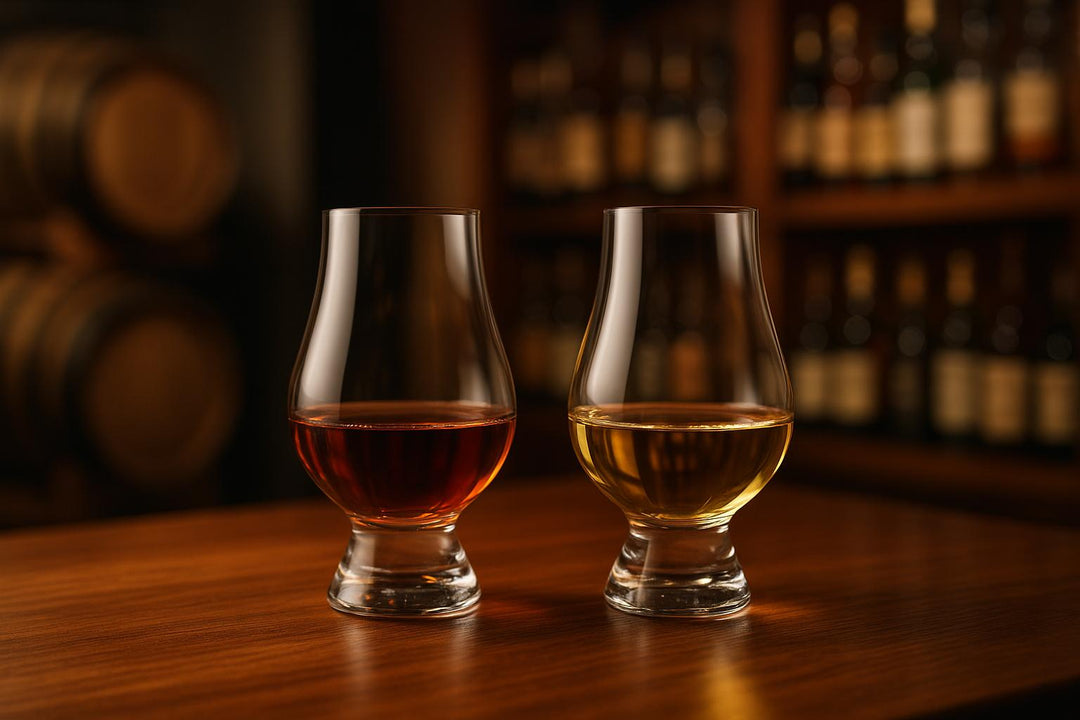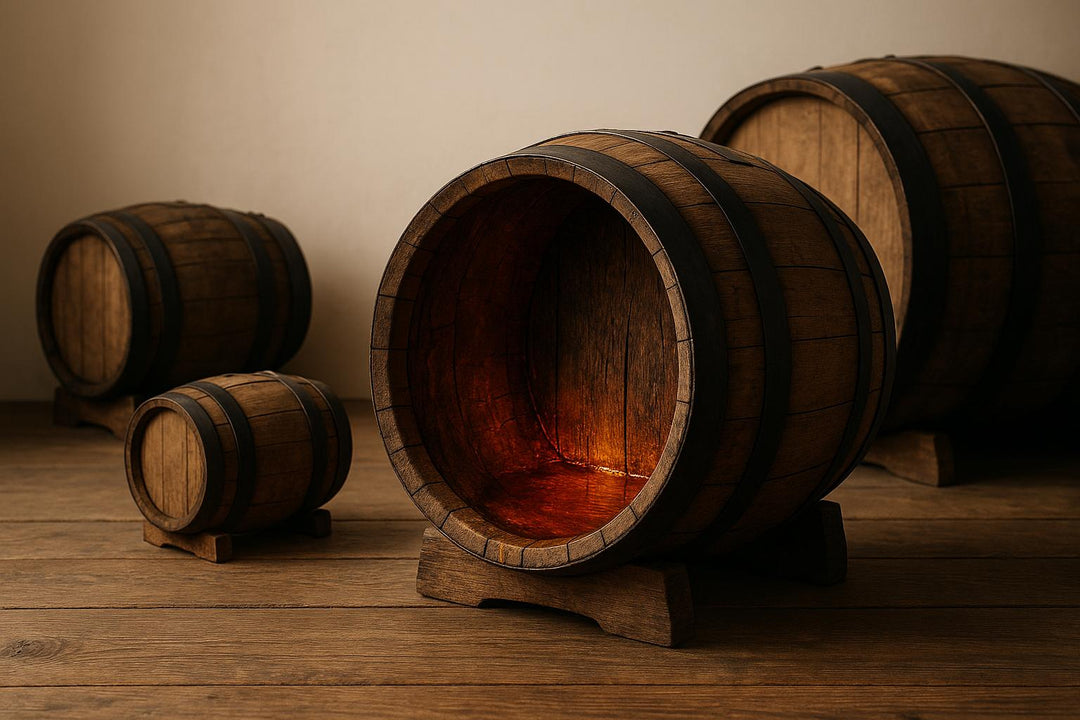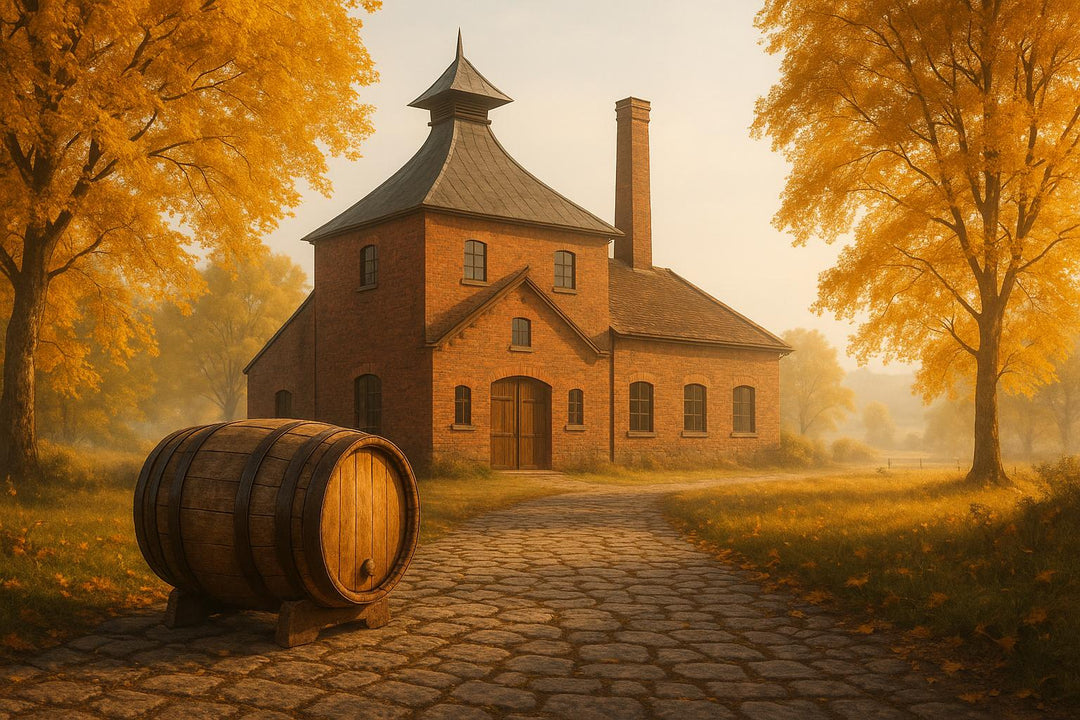Microbes play a key role in whisky maturation, shaping its flavour and complexity. During aging, yeast, bacteria, and moulds interact with the spirit and oak barrels to create unique tastes. Here's a quick breakdown:
- Yeast produces fruity and floral notes like apple and banana.
- Bacteria add tangy, sour, and nutty flavours by breaking down proteins and sugars.
- Moulds extract compounds from oak, introducing smoky, spicy, and woody elements.
These microorganisms thrive in specific conditions, influenced by barrel type, storage climate, and alcohol strength. Warmer climates speed up reactions, while the cask’s history and environment affect microbial activity, making every whisky distinct. Distillers now guide these processes to craft specific profiles, blending science with craftsmanship.
Microbes are the hidden architects of whisky’s transformation, turning raw spirit into a layered, flavourful drink.
What Happens During Whisky Cask Maturation? | Brewbird at Home
What's in Whisky Casks?
Whisky casks teem with a mix of life - yeasts, bacteria, and molds - each key to making its taste. What lives in a cask depends on things like the wood, where the tree was, how old it is, and where it sat. This mix makes sure each cask has its own soul. Let’s see how each tiny life adds to the whisky's taste.
Yeasts: Giving Sweet and Soft Smells
Yeasts, mostly the Saccharomyces cerevisiae type, are big in making whisky. They eat sugars from wood and drink, making esters that give off sweet and soft smells, like apple, pear, and banana. The choice of yeast type matters - each type leaves different amounts of esters and other stuff that tweak the taste. Simply put, the right yeast can balance the sweet and soft smells [3].
Bacteria: Putting in Zest and More
Bacteria in the barrels add a zesty tang that fits the drink. For example, Lactobacillus types make lactic acid, giving a nice tart taste and better feel in the mouth. Also, careful work with Acetobacter aceti leads to acetic acid, which puts in more layers. Studies show types like Lactobacillus brevis, Lactobacillus fermentum, and Lactobacillus paracasei are usual in malt whisky making [2]. These bacteria also bring cool taste bits like butyric acid (thinks parmesan) and benzaldehyde (thinks almond). Amazingly, these tiny lives do well in tough spots with low pH, low air, high heat, and lots of alcohol.
Molds: Getting Oak’s Hidden Touches
Molds have a big job, breaking down oak stuff to release deep tastes that come with age. Types like Aspergillus and Penicillium are good at breaking down oak lignin and lactones. They also work with the char on the barrel to shift phenolic parts into smoky, spicy, and nutty hints. More so, molds help make extra taste bits, like vanillin and syringaldehyde, which add creamy, woody, and even earthy sides to the whisky as time goes on.
Together, yeasts, bacteria, and molds birth a dance of changes that grows as the whisky ages. Moves in alcohol, air touch, and snack bits inside the barrel all play into how these tiny lives craft the drink’s taste, making each cask a one-of-a-kind work.
How Microbes Change Whisky Flavour
After fermentation, microbes continue to play a crucial role in shaping whisky's flavour during its maturation. This process involves intricate chemical reactions where microbes transform basic compounds into complex flavour molecules, creating the unique characteristics we associate with aged whisky.
Converting Residual Compounds in the Spirit
Microbial activity doesn’t stop once fermentation ends. Instead, it carries on during maturation, gradually converting residual compounds into new flavour elements. Martina Daute from Abertay University highlights that yeast not only produces alcohol but also generates volatile compounds essential to whisky's flavour profile [3].
Yeast remains pivotal in this stage, as it continues to form esters that contribute fruity and floral notes, such as apple, pear, and banana, well beyond fermentation. Residual yeast and bacteria persist in their metabolic activities, enhancing the whisky's complexity.
Lactic acid bacteria also add depth by producing organic acids that introduce a subtle tartness. These bacteria break down proteins into amino acids, which act as building blocks for even more intricate flavours. The specific raw materials used during production influence how microbes interact, resulting in distinct flavour profiles through varied metabolic pathways. These transformations set the stage for further interactions with the whisky cask.
Working with the Cask Environment
Once the microbial conversions in the spirit are underway, the cask environment takes over as a key player in refining these emerging flavours. Oak barrels provide nutrients that sustain microbial communities, while the charred layer of the wood acts as both a filter and a catalyst for chemical changes.
Microbes interact with the oak, breaking down lignin to extract compounds like lactones, vanillin, and other wood-derived elements that contribute vanilla, spice, and woody notes. These interactions between microbial enzymes and oak tannins create entirely new flavour molecules that neither the spirit nor the wood could produce alone. In this way, the cask becomes an active participant in the whisky’s maturation, rather than just a vessel.
The cask’s history also matters. Barrels that previously held bourbon, sherry, or other spirits harbour residual compounds and microorganisms that influence the whisky differently. Each type of cask fosters its own microbial community, leading to distinct flavour profiles. Additionally, the wood’s porosity allows for controlled oxygen exposure, encouraging beneficial microbial activity while keeping spoilage at bay.
Time and Warehouse Conditions
Temperature plays a major role in microbial activity and flavour development. Warmer conditions speed up chemical reactions between the spirit, microbes, and wood, leading to more pronounced flavours in less time. Studies have shown that higher fermentation temperatures encourage the formation of fruity and floral esters with sweeter notes [4].
Andy Watts, master distiller at James Sedgwick Distillery, explains how climate impacts maturation:
"Whisky matured in warm conditions does tend to mature quicker due to the accelerated interaction between spirit, cask, and air, resulting in a whisky that portrays itself as smoother and softer at a young age." [4]
Humidity levels also affect flavour development. High humidity can support certain bacterial communities while suppressing others, shaping the whisky’s profile. However, extreme humidity can lead to overpowering woody flavours, while low humidity risks underdeveloped characteristics [5].
Temperature fluctuations add complexity by altering microbial activity levels. For example, Kavalan Distillery in Taiwan experiences annual evaporation rates of around 12%, compared to Scotland’s 2-3%, due to its subtropical climate. This accelerates microbial and chemical reactions, significantly shortening the maturation process [4].
Ian Chang, master blender at Kavalan, describes their unique conditions:
"We find the warm temperature significantly speeds up the maturation process. The heat of Taiwan's subtropical climate and the humidity in Yilan speed up the chemical reactions between the oak barrel and the new-make spirit, which shortens the maturation process. It enables us to develop a rich and complex whisky in just a few years." [4]
Seasonal changes introduce a natural rhythm to maturation, with different microbes becoming more active during specific temperature and humidity ranges. These cycles contribute to the layered complexity of whisky, as new flavour compounds emerge and evolve over time. Together, the interplay of microbial activity, cask influence, and environmental conditions shapes the whisky’s final character.
sbb-itb-128d6c1
Factors Affecting Microbial Communities in Whisky Barrels
The unique conditions within each whisky barrel play a key role in shaping its microbial community. These factors, combined with microbial activity, give each barrel its distinct character, which explains why whiskies from the same distillery can taste so different.
Barrel Type and History
The type of oak and the barrel's history heavily influence the microbial populations inside. For instance, American white oak (Quercus alba) is known for its high vanillin content and wide grain structure. This allows the spirit to penetrate deeply, enabling microbes like bacteria and yeast to transform oak compounds into familiar flavours like vanilla, coconut, and spice notes[1]. In contrast, European oak (Quercus robur) delivers bolder flavours, often described as hints of dried fruit, nuts, and chocolate[1].
Freshly made barrels encourage intense microbial activity, as the fresh oak compounds provide abundant resources for microbes. On the other hand, barrels that have been reused over time develop more mature microbial communities, which tend to produce subtler and more complex flavour profiles with each successive use[1][6].
Warehouse Climate and Storage Methods
The climate in the warehouse and how the barrels are stored have a big impact on the microbial activity within. Temperature and humidity are two major factors. Warmer temperatures speed up microbial metabolism, while humidity levels influence how much alcohol or water evaporates. For example, high humidity favours the evaporation of alcohol, lowering the spirit's strength, whereas drier conditions cause water to evaporate more, concentrating the alcohol and altering the microbial environment[8].
Ian Thomas, distillery director at Virginia Distillery Co., highlights the role of climate in shaping whisky:
"If you compared two 3 year old whiskies made in a similar way but aged in two different climates - one cool and steady, one warm with big temperature swings - you would see more development and exchange of fatty acids, tannins, vanillins, and other maturation components in the warmer climate, leading to a more robust flavour profile." [4]
Seasonal temperature changes also cause the whisky to expand and contract within the barrel, enhancing the exchange of flavours and sustaining microbial activity throughout the year[7]. Additionally, the alcohol concentration at the time of casking has a direct influence on which microbes thrive during maturation.
Alcohol Strength at Casking
The alcohol strength when the whisky enters the barrel acts as a filter for microbial life. Higher alcohol concentrations generally inhibit many types of microbes, especially yeast[10]. For example, at Buffalo Trace Distillery, whisky is casked at an exact ethanol level of 62.5%, which strikes a balance - supporting beneficial microbes while keeping spoilage organisms at bay[9].
As whisky ages, evaporation changes the alcohol concentration. At Balcones, whisky enters the barrel at around 62.5% ABV, but after two years in a warm climate, the strength can rise to between 65% and 68%[4]. Early on, diverse microbial communities flourish, but as the alcohol level increases, only the most resilient microbes survive. This natural progression influences the development of flavours over time.
The interaction between barrel type, storage conditions, and alcohol strength ensures that each barrel evolves its own microbial ecosystem, contributing to the rich variety of flavours found in aged whisky.
Managing Microbes: Creating Premium Whisky
The magic of whisky lies in its layers of flavour, and much of that complexity comes from the unseen world of microbes. Distillers have moved beyond simply letting nature take its course; today, they use deliberate techniques to guide microbial activity within barrels, shaping the unique character of each whisky. Here's how they do it.
Developing Signature Flavour Profiles
Modern distillers have found ways to influence the microbial communities inside barrels to get the flavours they want. By tweaking conditions such as the pH of the spirit before it enters the barrel, they can steer microbial growth in specific directions. For instance, an acidic environment encourages bacteria that produce tangy, fruity notes. On the other hand, a more alkaline setting allows fungi to thrive, breaking down oak compounds into flavours like vanilla and spice[1].
Temperature control during fermentation and maturation is another crucial factor. Combined with managing oxygen levels, it has a significant impact on the balance of microbial populations.
Some distillers take it a step further by inoculating barrels with specific microbial cultures or scraping away old layers inside the barrel to encourage fresh microbial growth. Once barrels have developed distinct flavour profiles, their contents can be blended to create a more complex and balanced whisky[1].
The Role of Expert Curation
These carefully controlled microbial processes require a sharp eye and refined palate to bring out the best in every whisky. Understanding how microbes interact with the spirit during maturation is no small task, and expert curation plays a vital role in highlighting each whisky's unique character.
At The Really Good Whisky Company, this expertise is put to good use. Their curators select premium bottles that showcase the nuanced flavours shaped by years of natural ageing and microbial interaction. For whisky lovers, their tasting packs and bespoke bottling services offer a chance to explore these subtleties. And if you're in London, the boutique experience provides a hands-on look at the craftsmanship behind each bottle.
Conclusion: From Microbes to Maturity
Whisky maturation is a fascinating process where microbes play a pivotal role in transforming raw spirit into the refined drink we cherish. This intricate dance of microbial activity and cask conditions shapes every sip, turning science into art.
Key Points on Microbial Influence
Microbial communities are the hidden architects of whisky maturation. Yeasts, bacteria, and fungi work tirelessly to convert sugars, ethanol, and congeners into the flavour compounds that define each whisky’s character. These organisms also interact with the wood, breaking down its components to release a spectrum of flavours that make each bottle unique[1].
The type of oak used and its history add another layer of complexity. Warmer climates can speed up microbial activity, leading to quicker flavour development, while high humidity allows microbial populations to thrive compared to drier environments[1].
Every barrel holds its own distinct combination of microbes, wood, and environmental factors. This natural variation guarantees that no two whiskies are identical, even if they come from the same distillery[1]. Such diversity makes whisky tasting an endlessly rewarding experience, with each bottle offering its own story and nuances.
Celebrating Craftsmanship and Expertise
Understanding the role of these microbial processes enhances your appreciation for every dram. That hint of caramel or touch of spice you taste is the result of years of microbial transformation, carefully managed by skilled distillers.
This blend of science and artistry is at the heart of every bottle. It’s not just about managing microbes - it’s about harnessing their potential to create something extraordinary. At The Really Good Whisky Company, this profound understanding of microbial influence is reflected in their curated selection of rare and aged whiskies. Each bottle they offer showcases the incredible diversity born from the interplay of time, microbes, and craftsmanship.
Whether you’re sampling their tasting packs or investing in a rare bottle, you’re not just buying whisky - you’re experiencing the culmination of countless microbial interactions and the expertise of those who guide them. Every dram is a testament to this delicate balance of nature and skill.
FAQs
How do different types of oak barrels affect the flavour and microbial activity during whisky maturation?
The type of oak barrel used for whisky maturation has a profound impact on both its flavour and the activity of microbes. Different oak species, like American oak or Japanese Mizunara, contribute specific compounds such as vanillin, tannins, and spicy phenols. These elements interact with the whisky and the microbes, shaping distinct flavour profiles.
Factors like the barrel's porosity and the degree of toasting or charring also play a crucial role. They regulate oxygen flow and influence microbial growth within the wood. This encourages delicate chemical reactions and oxidation, gradually building the whisky's complexity. Over time, these interactions result in the deep, layered flavours that define the character of each whisky.
How do climate and storage conditions affect whisky maturation?
Whisky’s flavour and maturation are deeply influenced by the climate and storage conditions it’s exposed to. In warmer climates, the spirit ages faster as it expands into the wood of the cask, pulling out a richer array of flavours. Meanwhile, cooler climates slow this process, often leading to a gentler, more nuanced flavour profile.
Temperature swings and humidity levels also play a pivotal role. When temperatures shift, the whisky moves in and out of the cask, intensifying its interaction with the wood. Humidity, on the other hand, affects how much alcohol and water evaporate, which can subtly change the whisky’s balance and character. Together, these factors ensure that every whisky’s maturation process is one of a kind.
How do distillers use microbes to shape whisky flavours during maturation?
Distillers play a crucial role in shaping the flavour of whisky by carefully managing microbial activity throughout production and maturation. They keep a close eye on factors like temperature, pH levels, and oxygen exposure to guide the behaviour of microbes such as yeast and bacteria. These tiny organisms are responsible for producing the compounds that define the whisky's aroma and taste.
Certain microbes, like lactic acid bacteria, are particularly valued because they generate flavour-enhancing compounds such as esters and lactic acid, which add layers of complexity to the whisky. At the same time, distillers work diligently to limit harmful microbial contamination that could lead to unpleasant off-flavours. Striking this delicate balance ensures that each bottle of whisky delivers a rich and well-crafted character.






Leave a comment